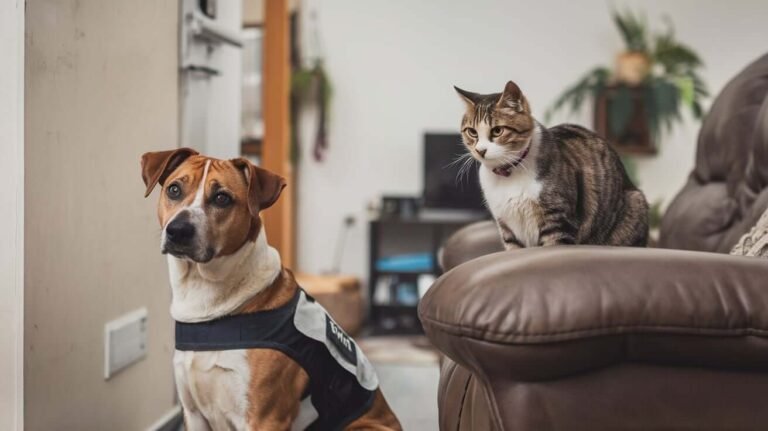What Can Cats Eat and Not Eat? 4 Toxic Foods to Cats
Cats are beloved companions, and ensuring their diet is both safe and nutritious is crucial for their overall health and well-being. As obligate carnivores, cats have unique dietary needs that must be met to support their energy, immune system, and longevity. This comprehensive guide will outline What Can Cats Eat and Not Eat? providing clarity for pet owners striving to make the best choices for their furry friends.

Table of Contents
- Understanding a Cat’s Nutritional Needs
- Can Cats Eat Human Food?
- What Can Cats Not Eat?
- What to Feed Cats
- Key Tips for Feeding Cats Safely
- Some Common Questions About What Can Cats Eat and Not Eat?
- Also Read: What Snakes Make Good Pets? 4 Fascinating Reasons
- Cat-Safe Foods to Keep on Hand
- What Foods Are Harmful to Cats?
- What to Do If Your Cat Eats Something Toxic
- Signs of Food Poisoning in Cats
- Practical Tips for Feeding Cats
- Also Read: What to Do When a Pet Dies: 3 Powerful Steps to Take When a Pet Dies
- Homemade Meals for Cats
- Homemade Treats for Cats: Safe and Healthy Options
- Foods Cats Can Eat Sparingly
- Foods That Cause Digestive Issues
- Creating a Balanced Diet for Your Cat
- The Importance of Regular Veterinary Checkups
- Recognizing Nutritional Deficiencies in Cats
- Recognizing Food Allergies in Cats
- Seasonal Considerations for Your Cat’s Diet
- Special Diets for Cats with Health Conditions
- Supporting Your Cat’s Dental Health Through Diet
- The Lifelong Benefits of Proper Nutrition To Your Cat
- Tips for Feeding Cats Safely
- European and American Standards for Cat Nutrition in 2024
- Final Thoughts
- FAQs About What Cats Can Eat and Not Eat
- Can cats eat dog food in an emergency?
- Are grains harmful to cats?
- What should I do if my cat eats something toxic?
- Can kittens eat the same foods as adult cats?
- Is it safe to give cats table scraps?
- Can cats eat dairy products?
- How often should I feed my cat?
- Can cats eat raw food?
- What treats are safe for cats?
- Can cats eat dog food?
Understanding a Cat’s Nutritional Needs
Cats require a high-protein, low-carbohydrate diet that mimics what they would eat in the wild. Their meals should include essential amino acids, such as taurine, fatty acids, vitamins, and minerals. Foods rich in these nutrients help support their growth, maintain healthy coats, and sustain overall health.
Can Cats Eat Human Food?
Yes, but with caution. Always ensure the food is plain, unseasoned, and cooked.
Good Human Foods For Cats That They Can Eat
Several human foods can be a nutritious addition to your cat’s diet. However, these should only complement their main food source:

Proteins: The Foundation of a Cat’s Diet
Cats thrive on animal-based proteins. Here are some safe protein options for your feline:
Eggs: Cooked eggs are a good source of protein and vitamins. Always avoid raw eggs due to the risk of salmonella.
Cooked Chicken: Skinless, boneless chicken is an excellent protein source.
Turkey and Duck: These lean meats can be a tasty alternative to chicken.
Fish: Cooked salmon, sardines, and mackerel are rich in omega-3 fatty acids. Avoid feeding raw fish frequently, as it can lead to nutrient deficiencies.
Beef and Lamb: Fully cooked lean cuts of beef or lamb are safe and nutritious.
Fruits Cats Can Eat
While fruits aren’t a primary part of a cat’s diet, some can be offered as occasional treats:
- Blueberries and Strawberries: Rich in antioxidants and safe in small amounts.
- Melon: Cantaloupe and honeydew provide hydration and vitamins.
- Bananas: A good source of potassium when offered in small, bite-sized pieces.
Can Cats Eat Vegetables?
Yes, some vegetables are safe and even beneficial. Cats may nibble on vegetables, but they should not be a significant part of their diet. Some safe options include:
- Cooked Carrots: High in beta-carotene and easy to digest.
- Zucchini: A low-calorie vegetable that cats can enjoy.
- Pumpkin: Canned, unsweetened pumpkin can aid digestion and alleviate constipation.
Can Cats Eat Dairy Products?
While many people associate cats with milk, most cats are lactose intolerant. However, there are a few dairy products they can tolerate in small amounts:
- Plain yogurt: Rich in probiotics.
- Hard cheeses: Like cheddar, in tiny quantities.
- Lactose-free milk: Specifically formulated for cats.
Avoid regular cow’s milk, as it can cause diarrhea and stomach upset.
What Can Cats Not Eat?
Toxic Foods to Cats
Certain foods are not just unhealthy but outright dangerous for cats. These include:
- Onions and Garlic: Both contain compounds that can cause anemia in cats.
- Chocolate: Contains theobromine, which is toxic to cats.
- Grapes and Raisins: Can cause kidney failure in cats.
- Alcohol and Caffeine: Both substances are highly toxic and should never be given to cats.
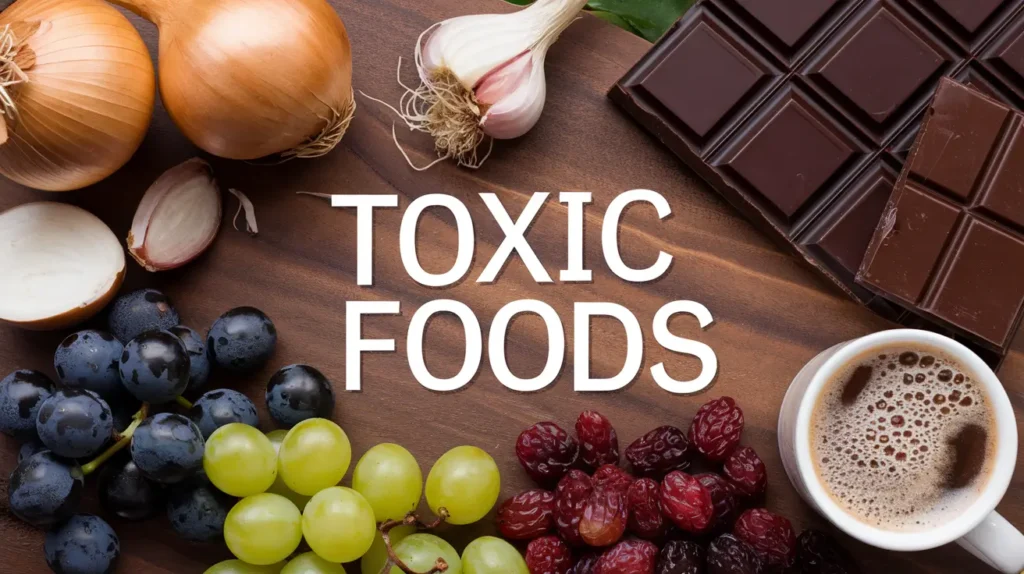
Raw Foods That Pose Risks
While raw diets are sometimes advocated, they come with risks:
- Raw Fish: Contains thiaminase, an enzyme that can destroy vitamin B1 (thiamine).
- Raw Meat and Eggs: May carry harmful bacteria like Salmonella and E. coli.
Harmful Human Foods
Avoid feeding cats table scraps or foods containing the following:
- Xylitol: This artificial sweetener, found in some sugar-free products, is toxic to cats.
- Fat Trimmings and Bones: Can cause digestive upset or choking.
- Dough: Uncooked dough can expand in a cat’s stomach, causing serious complications.

What to Feed Cats
The best diet for cats includes:
- High-quality commercial cat food.
- Occasional treats of cooked meat and fish.
- Fresh water: Always available.
Key Tips for Feeding Cats Safely
- Introduce New Foods Gradually: If trying new treats or foods, offer them in small amounts and monitor for adverse reactions.
- Avoid Overfeeding Treats: Limit treats to no more than 10% of your cat’s daily caloric intake.
- Stick to Cat-Specific Food: Commercial cat foods are specifically formulated to meet feline dietary needs.
- Fresh Water is Essential: Always provide clean, fresh water to keep your cat hydrated.

Some Common Questions About What Can Cats Eat and Not Eat?
What Does Cat Like to Eat?
Cats generally prefer foods rich in protein and fats. Their favorite meals often include:
- Cooked chicken or turkey: Both are highly palatable.
- Fish: Cooked salmon or tuna in moderation.
- Wet food: Cats often enjoy the texture and flavor of canned food.
- Eggs: Cooked and plain, as they are an excellent source of protein.
What Can Cats Eat From the Fridge?
Cats can enjoy certain items from the fridge, such as:
- Cooked chicken or turkey leftovers: Ensure they are unseasoned.
- Plain yogurt: If your cat tolerates dairy.
- Boiled vegetables: Like carrots or green beans.
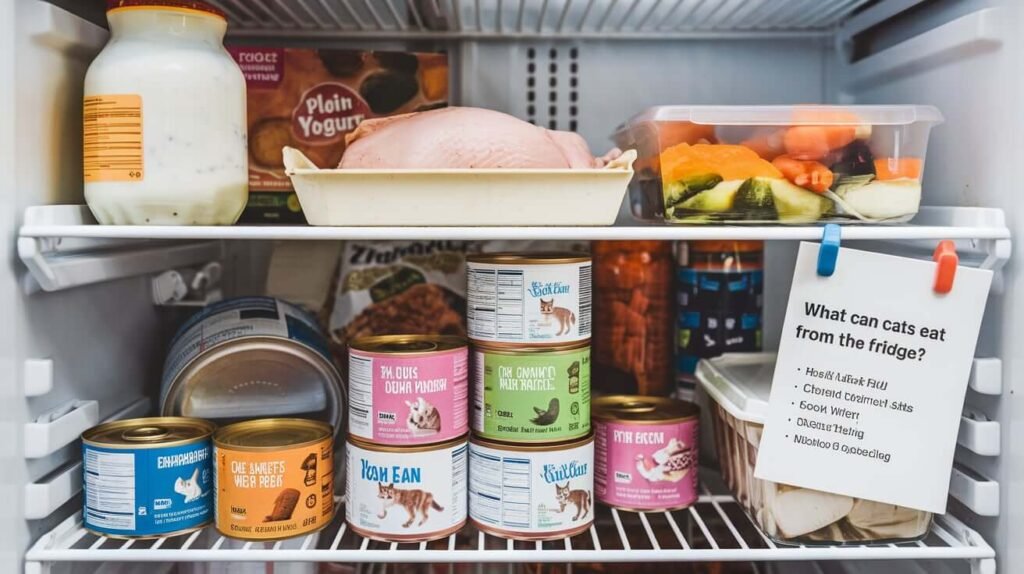
Make sure any food given is fresh and not seasoned with harmful ingredients.
What Can My Cat Eat?
Your cat can safely eat a variety of human foods, provided they are prepared correctly and given in moderation. These include:
- Cooked meat: Chicken, turkey, beef, and lamb.
- Cooked fish: Salmon, sardines, or mackerel without bones.
- Plain eggs: Fully cooked and scrambled or boiled.
- Vegetables: Such as green beans, carrots, and zucchini.
- Small fruits: Like blueberries, watermelon, and bananas.
Ensure that any food offered is free from harmful additives like salt, garlic, or onion.
What Do Cats Eat and Drink
Cats eat primarily meat, including chicken, beef, and fish, as they are obligate carnivores. They drink water but can also consume wet cat food for added hydration. Always avoid foods toxic to cats, such as chocolate, onions, and garlic.
What Can Cats Eat Every Day?
For daily meals, cats thrive on a high-protein, low-carbohydrate diet. Stick to these staples:
- High-quality commercial cat food: Wet and dry.
- Cooked meats: Like chicken or turkey.
- Occasional vegetables: Steamed or pureed for easy digestion.

Ensure your cat has constant access to fresh, clean water to stay hydrated.
How to Transition a Cat’s Diet
Switching your cat to a new diet requires careful planning to avoid digestive upset. Follow these steps for a smooth transition:
- Days 1–3: Mix 75% of the old food with 25% of the new food.
- Days 4–6: Adjust to 50% old food and 50% new food.
- Days 7–9: Move to 25% old food and 75% new food.
- Day 10 onwards: Fully switch to the new food.
Monitor your cat’s behavior, appetite, and stool during the transition. If you notice any adverse reactions, consult your veterinarian immediately.
How to Tell if Your Cat Likes a New Food
Cats can be finicky eaters. Here are signs your cat enjoys their new food:
- Eager approach: Your cat shows excitement at meal times.
- Clean bowl: They finish their food consistently.
- No digestive issues: Normal stools and no vomiting or diarrhea.
- Increased energy: Your cat appears more playful and energetic.
If your cat refuses the food, try offering it in a different texture (e.g., mash it or add warm water to enhance the aroma).
Also Read: What Snakes Make Good Pets? 4 Fascinating Reasons
Can Cats Eat Rice?
Yes, cats can eat small amounts of plain, cooked rice. Rice can help soothe an upset stomach and is sometimes included in bland diets for cats recovering from digestive issues. However, it should not be a staple food as it lacks essential nutrients cats need.

Can Cats Eat Bread?
Plain, fully cooked bread is not toxic to cats and can be given occasionally as a small treat. However, bread offers little nutritional value and should not replace their regular diet. Avoid bread containing raisins, garlic, or onions, as these are toxic to cats.
Can Cats Eat Peanut Butter?
Peanut butter is not toxic to cats, but it is high in fat and can cause digestive upset if consumed in large amounts. Additionally, some peanut butter contains xylitol, a sweetener that is extremely toxic to cats. It’s best to avoid peanut butter altogether.
Can Cats Eat Ice Cream?
Cats should not eat ice cream. Most cats are lactose intolerant, and the high sugar content is unhealthy. If you want to treat your cat, consider offering a small portion of frozen, unsweetened yogurt or a specially formulated cat treat.
Can Cats Eat Fish Every Day?
While fish like salmon and tuna are safe in small amounts, they should not be a daily food source. Overconsumption of fish can lead to mercury poisoning or a vitamin B1 deficiency. Always ensure fish is cooked and free of bones before offering it to your cat.

How Much Human Food Can Cats Eat?
Human food should only make up about 5-10% of your cat’s total diet. The majority of their nutrition should come from high-quality cat food formulated to meet their specific dietary needs.
Can Cats Eat Raw Meat or Fish?
Feeding raw meat or fish poses risks, such as bacterial contamination (e.g., salmonella, E. coli) and nutrient imbalances. If you choose to feed raw, consult your veterinarian to ensure the diet is safe and properly balanced.
Can Cats Eat Eggs?
Yes, cats can eat eggs if they are fully cooked. Eggs are an excellent source of protein and other essential nutrients. However, raw eggs should be avoided as they may contain harmful bacteria like salmonella.
Can Cats Eat Potatoes?
Cooked potatoes in small amounts are not harmful, but raw potatoes and potato skins contain solanine, which is toxic to cats. It’s better to avoid giving your cat potatoes altogether.
How Often Can I Give My Cat Treats?
Treats, including human foods that are safe for cats, should not exceed 10% of their daily caloric intake. Use treats as a reward or occasional snack, but ensure your cat’s primary diet remains balanced and nutrient-rich.
Cat-Safe Foods to Keep on Hand
If you’re looking for safe foods to keep readily available for your cat, consider:
- Boiled chicken breast: A protein-packed staple.
- Canned plain tuna or salmon: Use sparingly to avoid mercury exposure.
- Plain yogurt: Only if your cat tolerates lactose.
- Pumpkin puree: Helpful for digestion and a source of fiber.
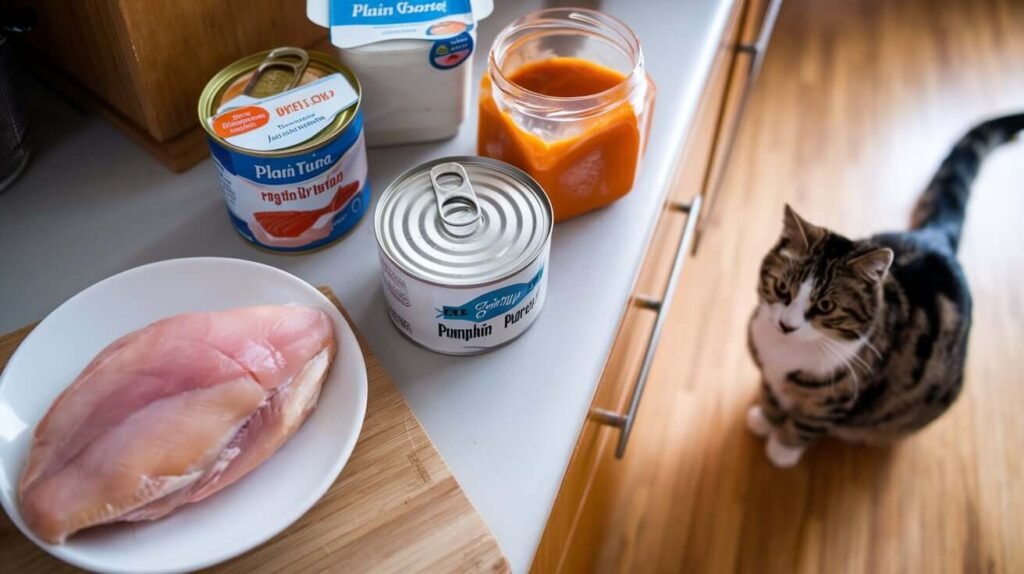
Always check with your veterinarian before making significant changes to your cat’s diet.
What Foods Are Harmful to Cats?
In addition to the toxic foods mentioned earlier, here are some other items to avoid:
- Fatty foods: Can cause pancreatitis.
- Artificial sweeteners: Xylitol is particularly dangerous.
- Cooked bones: They can splinter and cause choking or internal injuries.
- Raw yeast dough: Can expand in the stomach and produce alcohol during fermentation.
Keep harmful foods out of your cat’s reach, and educate family members about what is safe to feed them.
What to Do If Your Cat Eats Something Toxic
If you suspect your cat has eaten a toxic food, take these steps immediately:
- Identify the food: Check what your cat ate and how much.
- Call your veterinarian: They can provide tailored advice based on the situation.
- Monitor symptoms: Vomiting, diarrhea, lethargy, and seizures require urgent attention.
- Visit an emergency clinic: If your vet advises it or symptoms worsen.
Preventative care, like storing food securely, is the best way to avoid emergencies.
Signs of Food Poisoning in Cats
If your cat accidentally consumes something harmful, watch for these symptoms:
- Vomiting or diarrhea
- Lethargy
- Loss of appetite
- Excessive drooling
- Seizures

If you observe any of these signs, contact your veterinarian immediately.
Practical Tips for Feeding Cats
- Stick to portion sizes: Overfeeding can lead to obesity and health problems.
- Introduce new foods slowly: Monitor for allergic reactions or digestive issues.
- Avoid feeding from the table: This discourages begging and limits exposure to unsafe foods.
- Store leftovers properly: Refrigerate human foods you plan to give your cat later.
Also Read: What to Do When a Pet Dies: 3 Powerful Steps to Take When a Pet Dies
Homemade Meals for Cats
Creating homemade meals for your cat can be a great way to ensure they eat fresh, healthy, and safe foods. However, it’s important to balance the meals to meet their nutritional requirements. Some homemade meal ideas include:
- Chicken and Rice
- Ingredients: Cooked chicken breast (shredded), plain boiled rice, and a small amount of cooked carrots.
- Preparation: Mix all ingredients together and serve in small portions.
- Fish and Vegetable Mash
- Ingredients: Cooked salmon, steamed green beans, and mashed pumpkin.
- Preparation: Combine the ingredients into a soft mash.
- Turkey and Egg Delight
- Ingredients: Ground cooked turkey and scrambled eggs.
- Preparation: Mix them together and serve slightly warm.
Remember to avoid adding salt, spices, or oils. Always consult your vet before transitioning to homemade diets to ensure your cat receives essential nutrients like taurine, which is vital for their health.
Homemade Treats for Cats: Safe and Healthy Options
Preparing treats at home can be a rewarding way to pamper your cat while ensuring their safety. Here are a few simple, nutritious treat ideas:
- Chicken Bites: Dice cooked, unseasoned chicken into small pieces for an irresistible snack.
- Tuna Patties: Mix canned tuna (in water, not oil) with a small amount of cooked pumpkin or egg. Shape into bite-sized patties and serve.
- Salmon Snacks: Bake small salmon pieces without any seasoning. This protein-rich treat is packed with omega-3s.
- Frozen Yogurt Drops: Use lactose-free plain yogurt, place small drops on a baking sheet, and freeze for a refreshing summer treat.

Commercial Treats: What to Look For
If you prefer to purchase cat treats, be sure to select products designed specifically for felines. Look for:
- High Protein Content: Ensure the primary ingredient is a quality animal protein.
- No Artificial Additives: Avoid treats with artificial colors, flavors, or preservatives.
- Low Carbohydrates: Cats don’t metabolize carbohydrates well, so limit their intake.
Foods Cats Can Eat Sparingly
Some foods can be safe for cats in very small amounts but should not become a regular part of their diet. These include:
- Peanut Butter: While not toxic, it is high in fat and sugar, which can lead to obesity or upset stomachs if overfed.
- Cheese: A small cube occasionally is fine for most cats, but lactose intolerance varies.
- Rice and Oats: These cooked grains can be given occasionally to help with digestive issues but lack the nutrients cats primarily need.
Foods That Cause Digestive Issues
Some foods are not toxic but can cause stomach upset or other mild health issues, such as:
- Milk and Cream: Despite the stereotype of cats loving milk, most are lactose intolerant.
- Fatty Foods: High-fat foods can lead to pancreatitis, a serious and painful condition.
- Spicy Foods: Cats are sensitive to spices, which can cause digestive upset or discomfort.

Creating a Balanced Diet for Your Cat
A balanced diet is crucial for your cat’s overall health. When preparing your cat’s meals, focus on the following:
- Include High-Quality Proteins: Prioritize animal-based proteins like chicken, turkey, or fish.
- Incorporate Essential Fatty Acids: These can be found in fish oils or specialized supplements.
- Avoid Excessive Carbohydrates: Stick to grain-free diets or those with minimal fillers.
You may also consider adding cat-safe vitamins and supplements, especially if your cat has specific dietary needs. Always consult your veterinarian before introducing new supplements.
The Importance of Regular Veterinary Checkups
Routine vet visits are essential to monitor your cat’s health and dietary impact. Your veterinarian can:
- Provide Nutritional Guidance: Recommend diets tailored to your cat’s age, weight, and health conditions.
- Identify Allergies: Help pinpoint any food allergies or sensitivities your cat may have.
- Perform Routine Screenings: Detect and address any underlying issues early, such as obesity or nutrient deficiencies.

Recognizing Nutritional Deficiencies in Cats
A poorly balanced diet can lead to nutritional deficiencies. Watch for these warning signs:
- Lethargy: Low energy levels may indicate a lack of essential vitamins.
- Dull coat: A dry, brittle coat can point to omega-3 or protein deficiencies.
- Weight loss: Could result from insufficient caloric intake.
- Behavioral changes: Irritability or reduced activity might be due to a lack of essential nutrients.
If you suspect a deficiency, consult a vet for advice on supplements or dietary adjustments.
Recognizing Food Allergies in Cats
Food allergies in cats are relatively rare but can occur. Common symptoms include:
- Chronic itching or skin irritation
- Frequent ear infections
- Vomiting or diarrhea
- Flatulence or bloating

If you suspect your cat has a food allergy, consult your veterinarian to determine the specific allergen. A limited-ingredient diet or hypoallergenic cat food may be recommended.
Seasonal Considerations for Your Cat’s Diet
Just like humans, cats may have different dietary needs depending on the season:
- Winter: Cats may require slightly more calories in colder months to maintain body heat, especially if they are outdoor cats. Adding fatty fish or higher-calorie wet food can help.
- Summer: Hydration becomes more critical in hot weather. Offer chilled wet food or ice cubes made from tuna water to encourage fluid intake. For outdoor cats, ensure their food and water dishes are kept in shaded areas to prevent overheating.
Special Diets for Cats with Health Conditions
If your cat has specific health issues, their diet may need to be tailored. Here are some common conditions and dietary solutions:
- Obesity: Use portion-controlled feeding and opt for low-calorie, high-protein diets.
- Diabetes: Cats with diabetes benefit from diets low in carbohydrates and high in protein. Veterinary-prescribed food is often necessary.
- Kidney Disease: Cats with kidney issues often require diets low in phosphorus and sodium, with added omega-3 fatty acids.
- Urinary Tract Problems: Specialized urinary health diets can help prevent crystal formation and promote a healthy pH balance. Always consult your veterinarian to determine the best dietary approach for managing chronic conditions.

Supporting Your Cat’s Dental Health Through Diet
Dental health is an often-overlooked aspect of feline nutrition. Poor dental hygiene can lead to pain, infections, and systemic health issues. Here’s how you can support your cat’s oral health:
- Crunchy Kibble: Dry food can help scrape plaque off teeth.
- Dental Treats: Specially formulated treats help reduce tartar buildup.
- Raw Meaty Bones: For cats accustomed to raw diets, meaty bones can promote dental cleaning. Always consult your vet before introducing bones.
The Lifelong Benefits of Proper Nutrition To Your Cat
A well-balanced diet tailored to your cat’s individual needs promotes:
- A Shiny Coat: Healthy fats and proteins result in a glossy, soft coat.
- Strong Immunity: Proper nutrients enhance your cat’s ability to fight illnesses.
- Increased Longevity: Cats fed an optimal diet are more likely to live longer, healthier lives. Investing in quality food and understanding your cat’s dietary requirements pays dividends in their overall happiness and well-being.
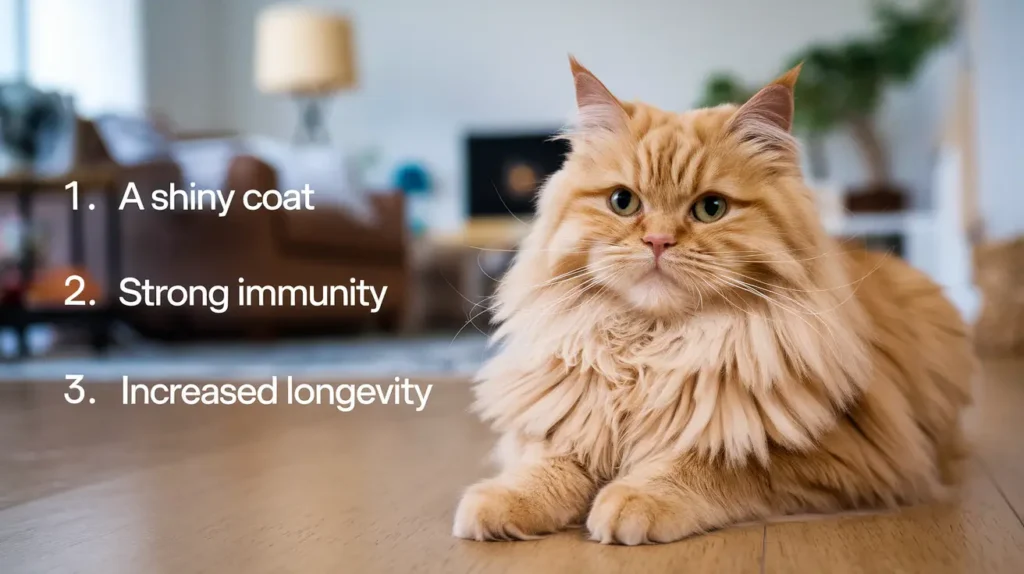
Tips for Feeding Cats Safely
Always prioritize your cat’s safety by avoiding heavily spiced, salted, or seasoned foods. Cook any food you plan to give them thoroughly and introduce new foods one at a time to identify potential allergies. Freshwater should always be available, and treats should never replace their main diet.
European and American Standards for Cat Nutrition in 2024
European Guidelines (FEDIAF)
FEDIAF, the European Pet Food Industry Federation, outlines stringent nutritional requirements to ensure complete and balanced diets for cats. These guidelines, updated recently in collaboration with veterinary and academic experts, specify precise levels of macronutrients, vitamins, and minerals based on a cat’s life stage (kitten, adult, senior). They also account for physiological conditions like pregnancy and lactation. For instance:
- Taurine: Critical for cardiac and retinal health, with specific minimum levels prescribed.
- Protein: High-quality animal protein is emphasized due to cats’ obligate carnivorous nature.
FEDIAF also promotes transparency in labeling, helping pet owners make informed choices regarding claims such as “natural” or “grain-free”.

American Guidelines (AAFCO)
In the U.S., the Association of American Feed Control Officials (AAFCO) has rolled out updated model regulations for 2024 as part of the Pet Food Label Modernization (PFLM) project. Key aspects include:
- Ingredient Transparency: Stricter requirements for listing ingredients and their sources.
- Claims Regulation: More robust standards for terms like “organic” and “human-grade” to avoid misleading consumers.
- Nutritional Adequacy: Comprehensive nutrient profiles tailored to different life stages and specific health needs, aligning with the latest scientific research.
For example, AAFCO emphasizes maintaining proper levels of essential nutrients like taurine, arachidonic acid, and vitamin A, which are indispensable for cats. Additionally, the calorie content and feeding guidelines must be clearly stated on packaging to prevent overfeeding or underfeeding.
Similarities and Differences
While both organizations aim to ensure pet health, their regulatory approaches differ slightly:
- Nutritional Focus: Both prioritize high-quality, bioavailable nutrients but differ in certain dietary benchmarks.
- Labeling: AAFCO’s recent focus on transparency aligns closely with European standards, reflecting global trends towards accountability in pet food production.
Final Thoughts
Your cat’s health begins with a balanced, species-appropriate diet. While exploring human foods can be fun and rewarding, it’s crucial to ensure these additions are safe and nutritionally beneficial. Always consult your veterinarian when in doubt, and remember that moderation is key to a healthy and happy feline.
FAQs About What Cats Can Eat and Not Eat
Here are some frequently asked questions about feeding cats and ensuring their dietary safety:
Can cats eat dog food in an emergency?
While cats can eat dog food in an emergency, it is not a suitable long-term solution. Dog food lacks essential nutrients, such as taurine and arachidonic acid, which cats need to thrive. Prolonged consumption of dog food can lead to serious health issues in cats.
Are grains harmful to cats?
Cats don’t require grains in their diet, as their digestive systems are designed for animal-based proteins. While small amounts of grains like rice or oats may be safe, they should never make up a significant portion of a cat’s diet.
What should I do if my cat eats something toxic?
If you suspect your cat has consumed a toxic food, contact your veterinarian or an animal poison control center immediately. Keep details of what and how much was ingested, and never attempt to induce vomiting without professional guidance.
Can kittens eat the same foods as adult cats?
Kittens have different nutritional needs than adult cats. They require a diet higher in protein and fat to support growth and development. Commercial kitten food or veterinarian-recommended homemade diets are best for kittens.
Is it safe to give cats table scraps?
Feeding cats table scraps is not recommended, as many human foods contain seasonings, fats, or toxic ingredients that can harm cats. It’s safer to stick to foods specifically prepared for feline consumption.
Can cats eat dairy products?
Many cats are lactose intolerant, meaning they cannot digest lactose in milk and dairy products. While some cats may tolerate small amounts of plain yogurt or hard cheeses, it’s generally safer to avoid dairy to prevent stomach upset.
How often should I feed my cat?
Most adult cats should be fed twice a day. Kittens may need smaller, more frequent meals.
Can cats eat raw food?
While some advocate for raw diets, they carry risks of bacterial contamination. Always consult your vet before feeding raw food.
What treats are safe for cats?
Small pieces of cooked chicken, plain fish, or cat-specific treats are safe options.
Can cats eat dog food?
No. Dog food lacks essential nutrients like taurine and can lead to deficiencies over time.


